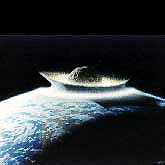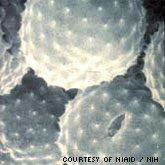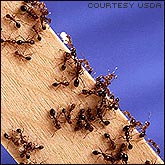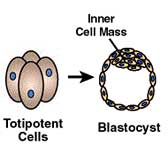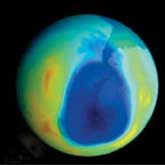The Melting Point
 Physical properties of a material fall into two categories: intrinsic properties determined by the structure of the particular molecule, and bulk properties characteristic of quantities of molecules together as bulk solids, liquids, or gases. The melting point of a pure substance is a bulk property and represents the point of transition of physical state from solid to liquid. Molecules of a substance must possess a specific amount of thermal energy in order for the solid-to-liquid phase transition to occur. The energy of a molecule is expressed in the vibrations of the interatomic bonds. The more energy a molecule possesses, the more energetic are the vibrations of the bonds within the molecule. In the solid state, the mobility of the molecules is restricted due to intermolecular attractions that keep the molecules within an ordered array (or crystal structure).
Physical properties of a material fall into two categories: intrinsic properties determined by the structure of the particular molecule, and bulk properties characteristic of quantities of molecules together as bulk solids, liquids, or gases. The melting point of a pure substance is a bulk property and represents the point of transition of physical state from solid to liquid. Molecules of a substance must possess a specific amount of thermal energy in order for the solid-to-liquid phase transition to occur. The energy of a molecule is expressed in the vibrations of the interatomic bonds. The more energy a molecule possesses, the more energetic are the vibrations of the bonds within the molecule. In the solid state, the mobility of the molecules is restricted due to intermolecular attractions that keep the molecules within an ordered array (or crystal structure).
As the thermal energy contained by a molecule increases, the vibrations of the bonds (and hence of the molecules themselves) become more energetic. Eventually a point is reached at which the intermolecular attractive forces can no longer contain the molecular motion within an ordered array. At this point the ordered array breaks down and the molecules become much more mobile relative to each other. The material melts. Since the melting point of a material is demonstrated by the transition from the solid phase to the liquid phase, it stands to reason that every material that can exist in a solid phase and in a liquid phase must have a melting point. The melting point occurs at a different temperature for most materials. Water melts at 0, sodium chloride melts at 801, and hydrogen melts at -259.14.
The term 'melting point' suggests and is usually used to indicate the change of state from solid to liquid due to an increase in temperature. When the temperature is decreased, the phase transition occurs from the liquid state to the solid state, molecular vibrations become less energetic until the intermolecular attractive forces are able to contain them within an ordered array (or crystal). This transition is called the 'freezing point' of the material. The melting point and freezing point of a pure compound occur at the same temperature. The use of either term is acceptable but generally implies an appropriate methodology such as the use of laboratory equipment specific for the observation of the melting behavior of solids or the freezing behavior of liquids. Generally, 'melting point' is used for materials that are solids at room temperature, and 'freezing point' is used for materials that are liquids at room temperature.

